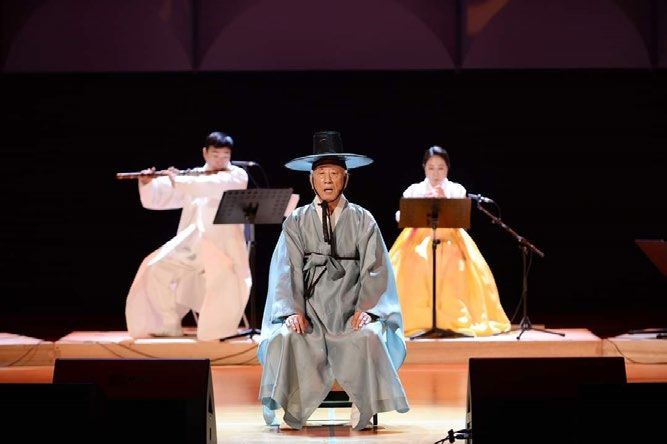Resonating Traditions: Exploring the Healing Melodies of Korean Vocal Music
- Seung-Kook Kim

- Apr 30, 2024
- 4 min read

As we suddenly stop while walking on the street and observe the busy passersby, it becomes clear that everyone appears preoccupied. This state of busyness, perhaps driven by survival instincts, leaves us feeling desolate and devoid of mental space. Personalities have become urgent, fixated solely on fast-track decisions.
In the past, it took a month to write, erase, and perfect a letter confessing love to a beloved. There was a time when another month was spent waiting anxiously for a reply. Nowadays, we live in an era where we exchange thoughts with a few lines of text messages on our smartphones within minutes.
In some cases, people risk their lives over trivial matters with neighbors. Many adopt a combative demeanor when behind the wheel. It is an era that calls for spiritual purification.

Amidst these circumstances, traditional Korean vocal music has begun to garner attention as healing and slow music. This includes forms like Gagok (가곡), Lyrics, and Sijo (시조).
Korean traditional music is not widely integrated into everyday life currently, but many Koreans can distinguish between Pansori, Namdo folk songs, and Gyeonggi folk songs. However, not many accurately differentiate between traditional vocal music Gagok, lyrics, Sijo, and Chang (창: Korean traditional narrative song).
Collectively referred to as "Jeongga (정가)" throughout the songs, lyrics, Sijo, and Chang, Jeongga signifies "songs of high character, correctness, and confidence."
Korean traditional music is broadly categorized into court music (Jeong-ak) and folk music. Jeongga refers to vocal music in Jeong-ak.
Gagok is likened to the deep and profound beauty of Goryeo celadon. It shares similarities with Sijo but comprises five chapters. While Sijo was enjoyed by commoners, Gagok was favored by scholars in refined settings. Gagok is sung with small-scale orchestral accompaniments featuring instruments like Gayageum, Geomungo, Daegeum, Janggu, Haegeum, and Sepiri.
Currently, 41 Gagoks are preserved, including 26 by Namchang (male performers) and 15 by Yeochang (female performers). Designated as national intangible cultural properties in 1969, these songs were listed on the "UNESCO Representative List of Human Intangible Heritage" in 2010. Gagok is often compared to the deep and deeply jade Goryeo celadon.
Let me introduce the lyrics of a female singer's song "Ilgak":
(초장) 일각(一刻)이 삼추(三秋)라 하니 (2장) 열흘이면 몇 삼추요 (3장) 제 마음 즐겁거니 남의 시름 생각하랴 (4장) 천리(千里)에 (5장) 임 이별하고 잠 못 일워 하노라.
Translated meaning:
(Chapter 1) A quarter of an hour feels like three autumns (Chapter 2) How many autumns pass in ten days (Chapter 3) Why worry about others' troubles when you're happy (Chapter 4) Separated by a thousand miles (Chapter 5) Sleep eludes me after our goodbye
These lyrics are compared to simple and pure Joseon porcelain. They represent an intermediate form between Sijo and traditional songs, incorporating colorful and delicate expressions of folk songs. The rhythmic and melodic elements are diverse, akin to Joseon Baekja's simplicity and purity.
In principle, Lyrics are sung alone without accompaniment, though sometimes with a small orchestra. Designated as a national intangible cultural property in 1971, there are 12 known Lyrics, including "Baekgusa," "Jukjisa," "Chunmyeongok," "Eobusa," "Gilgunak," "Byeolgok," "Gwonjuga," "Suyangsanga," "Cheosaga," "Yangyangga," "Maehwataryeong," and "Hwanggyesa."
Let me introduce the first verse of "Baekgusa":
백구야 펄펄 나지 마라 너 잡을 내 아니로다 성상(聖上)이 버리시니 너를 좆아 예 왔노라 오류춘광(五柳春光) 경(景) 좋은데 백마금편화류(白馬金鞭花遊) 가자
Translated meaning:
White seagull, don't fly fast I wouldn't catch you I came here after you because the king abandoned me The willow's spring light is good, so dress up well and let's go see flowers.
Sijo, also known as Sichang, refers to vocal songs easily sung and enjoyed by simplifying traditional songs. Comprising three Chapters (Cho Jang, Joong Jang, Jong Jang) with three scales, Sijo has four or five melodies like Pyeong Sijo, Tongdyeong Sijo, and Private Sijo, handed down over generations. Often accompanied by a double-headed drum or knee rhythm without instruments, Sijo is the daily and practical music of the general public.
Let me introduce a Sijo by the Jo Seon Dynasty scholar Seo Kyung-deok:
마음이 어린후이니 하는 일이 다 어리다 만중운산에 어내 님 오리마는 지는 잎 부는 바람에 행여 가 하노라
Translated meaning:
Because my heart is childish, everything I do seems childish How would you ascend the mountains cloaked in myriad clouds I wonder if you'll come with the sound of leaves rustling in the wind.

Korean traditional vocal music, including Gagok, Lyrics, and Sijo, serves to restore lost egos and heal wounded souls. Sichang (Song of Poetry) refers to reciting Chinese poems like Chilonyulsi (seven-word poem) with added yin. Accompanied by daegeum, notable Sichang pieces include "Gyeongpodae," "Mankyeongdae," "Chokseokru," "Manyu Moomin," "Yeongpung," and "Gwansan Yongma."
In an era of advanced science and technology, aesthetics of waiting and slowness are crucial. Similar to Goeun's poem "I saw it when I went down / The flower I didn't see when I went up," traditional Korean Gagok, Lyrics, and Sijo are ideal for restoring lost egos and healing wounded souls.




Comments